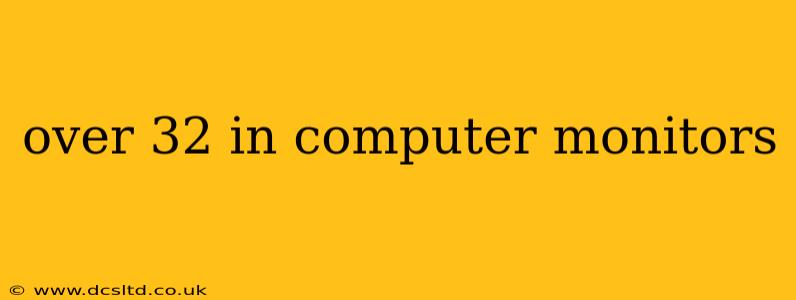The world of computer monitors is constantly evolving, and one trend that's gaining significant traction is the rise of monitors exceeding 32 inches. These expansive displays offer an immersive viewing experience, perfect for professionals, gamers, and anyone who demands exceptional visual fidelity. But navigating the options can feel overwhelming. This comprehensive guide will delve into the benefits, considerations, and key features of monitors larger than 32 inches, helping you choose the perfect fit for your needs.
What are the benefits of a monitor over 32 inches?
The most immediate benefit is the increased screen real estate. This allows for greater multitasking, effortless window management, and significantly improved productivity. Imagine having multiple applications open simultaneously without the constant need to minimize and maximize windows. For creative professionals, like graphic designers and video editors, this extra space is invaluable, allowing for more detailed work and a more comfortable workflow. Gamers benefit from a more immersive and visually stunning experience, with enhanced detail and wider fields of view.
What are the different types of monitors over 32 inches?
The market offers a variety of technologies for monitors exceeding 32 inches:
- IPS (In-Plane Switching): Known for their excellent color accuracy, wide viewing angles, and vibrant visuals. These are ideal for photo and video editing.
- VA (Vertical Alignment): Offering deep blacks and high contrast ratios, VA panels are a popular choice for gaming and home entertainment. However, viewing angles might not be as wide as IPS.
- TN (Twisted Nematic): Generally offering faster response times and lower latency, making them a preferred choice for competitive gaming. However, color accuracy and viewing angles often lag behind IPS and VA.
- OLED (Organic Light-Emitting Diode): These panels provide incredible contrast, perfect blacks, and vibrant colors. However, they tend to be more expensive than IPS, VA, and TN.
Choosing the right panel type depends heavily on your priorities. If color accuracy is paramount, IPS is a strong contender. For gamers seeking fast response times, TN might be more suitable. And for the ultimate visual experience, OLED offers unparalleled picture quality.
What resolution should I choose for a monitor over 32 inches?
Resolution plays a critical role in the overall viewing experience. For monitors over 32 inches, 4K (3840 x 2160) resolution is highly recommended. This ultra-high definition provides incredibly sharp text and images, making it ideal for demanding tasks like photo editing, video editing, and gaming. While lower resolutions are available, they might result in a less crisp image on such a large display. Consider also the pixel density (PPI – Pixels Per Inch) to ensure a sharp and clear picture, avoiding a blurry or pixelated look.
Are there any downsides to using a large monitor?
While large monitors offer many advantages, there are some drawbacks to consider:
- Price: Larger monitors, especially those with high resolutions like 4K, tend to be more expensive than smaller models.
- Space Requirements: You'll need a considerable amount of desk space to comfortably accommodate a monitor over 32 inches.
- Potential for Eye Strain: While not inherent to the size, prolonged use of any large screen can lead to eye strain. Maintaining proper posture, taking breaks, and adjusting brightness are crucial.
- Compatibility: Ensure your graphics card and system can handle the resolution and refresh rate of the chosen monitor.
What about curved monitors over 32 inches?
Curved monitors provide an immersive viewing experience, especially beneficial for gaming and movies. The curvature reduces eye strain by minimizing the distance your eyes need to travel across the screen. However, some users find the curvature distracting for productivity tasks. Consider your primary use case before choosing a curved model.
How much should I spend on a monitor over 32 inches?
The price range varies greatly depending on the size, resolution, panel type, and features. You can find monitors exceeding 32 inches starting at a few hundred dollars and going up to several thousand for high-end models with advanced features. Set a budget and prioritize features that are most important to you.
What are the best features to look for in a monitor over 32 inches?
Beyond size and resolution, consider these key features:
- Refresh Rate: A higher refresh rate (e.g., 144Hz or higher) provides smoother visuals, especially important for gaming.
- Response Time: A lower response time minimizes motion blur and ghosting.
- HDR (High Dynamic Range): This enhances the contrast and color range, delivering a more realistic and vibrant image.
- Connectivity: Ensure the monitor offers sufficient connectivity options (HDMI, DisplayPort, USB-C, etc.) to suit your needs.
- Adjustability: Look for features like height adjustment, tilt, and swivel to optimize ergonomics and comfort.
Choosing a monitor over 32 inches is a significant investment. By carefully considering your needs, budget, and the factors discussed in this guide, you can find the perfect large-screen display to enhance your computing experience.
